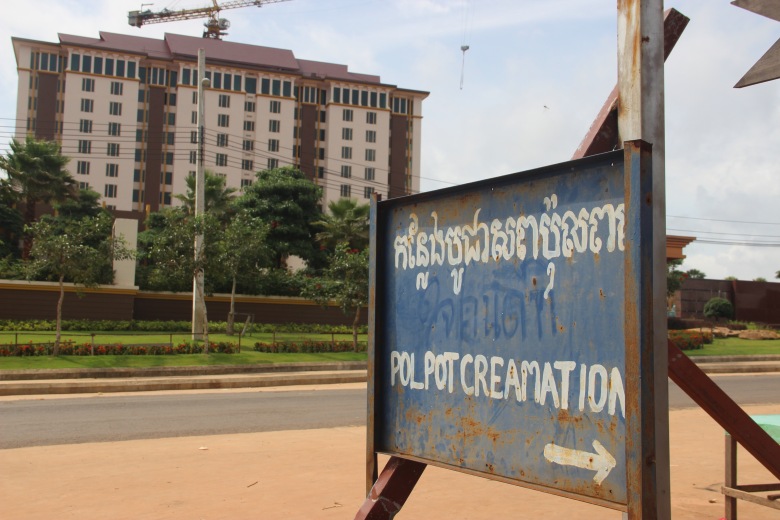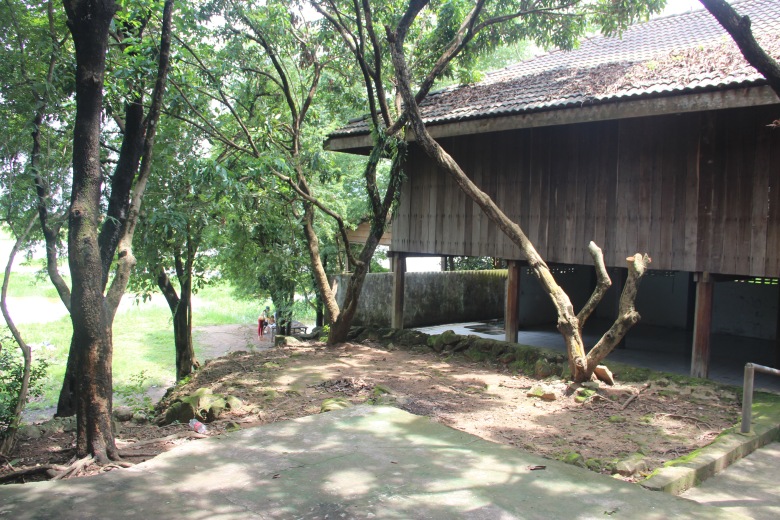

Appeared in The Edge Review (Malaysia), 2014
By SHANE WORRELL / Anlong Veng, Cambodia
If I had gazed too long at the gigantic casino – which, as it ascends skyward, interrupts the view of a splendid landscape – I might have missed the small, rusted sign opposite.
After driving around admiring green fields, picturesque mountains and the occasional waterfall, I realised Oddar Meanchey province, near the Thai border in northwestern Cambodia, offers two more choices for tourists on a different path from Angkor Wat to Preah Vihear Temple: Khmer Rouge tourism and casino tourism.
Not interested in the bright lights and late nights, I set out for the grave of Pol Pot, the brutal Khmer Rouge leader responsible for an estimated 1.7 million deaths. When the Khmer Rouge fell in 1979, after almost four years of totalitarian rule, Pol Pot and fellow leaders fled to the border, eventually capturing Anlong Veng town and waging a bloody resistance that lasted until the late 1990s.
The sign to the site of his cremation pointed me down a dirt track, across a rustic, unremarkable field in mostly beautiful highlands. There, a greying man, the caretaker, seemed surprised to have visitors. He loosened a rope blocking the entrance and later repeated to me an enduring rumour: that Pol Pot was poisoned to death in 1998.
At the time of his death, The Phnom Penh Post carried the headline “burned like old rubbish.” His gravesite, like his cremation, is similarly basic and unremarkable. But, in this serene setting, the simplicity of the body-length pile of soil, covered by a low, triangular roof and surrounded by a small fence, invites contemplation. Beside it, a Ministry of Tourism sign, itself rusted and faded, implores visitors to “please help” preserve this historic site.
Tourism is burgeoning in Cambodia. Visitors to Angkor Wat in Siem Reap, the Killing Fields and the S-21 genocide museum in Phnom Penh pour millions of dollars each year into surrounding hotels and restaurants.
In Oddar Meanchey, what few guesthouses and hotels there are, are mostly empty. The government has expressed a desire to preserve historically important Khmer Rouge sites, but years on, little money has found its way into restoration projects.
In Anlong Veng town, the Khmer Rouge “capital” during the 1990s, recently resigned deputy district governor Nhem En scrolls through photos on his computer. It is late afternoon and we sit in the heat of his empty guesthouse, where rooms cost US$7 per night.
En, a former Khmer Rouge photographer, took the infamous and chilling mug shots of prisoners at S-21 before their murder. They hauntingly stare back at everyone who visits what is now a museum in the capital.
En says he has about 5,000 more photos, including ones of top Khmer Rouge leaders, he wants to share in a museum of his own in Anlong Veng.
“These photos will surprise everyone,” he says.
His motive, he has previously said, is money, something for which he has unsurprisingly been criticized.
But the 54-year-old now says he would use profits to fund schools and hospitals in his “forgotten” town, some 125 kilometres from thriving Angkor Wat.
“Tourism can help us,” he says. “The young people have no jobs. They have to move to Siem Reap or Thailand.”
On the outskirts of Anlong Veng town, several murals adorn the walls of the shell that was once the house of Ta Mok, a Khmer Rouge leader known as “The Butcher” and “Brother Number Five”. The remains, which overlook Mok’s man-made swampy lake, are intriguing. Relics, such as a bunker and a prison van, are sobering reminders of the past.

When I visit the site, only a handful of people, all Cambodian, are present. Most of them have come to relax by the water.
“Only a small number of foreigners come here,” said ticket-seller Sun Roeun, 62. “It’s not advertised much.”
Roeun, a former Khmer Rouge cadre who helped build the Butcher’s house, said he was waiting for the government to act on its promise to upgrade the site.
These plans, he said, included fully restoring the houses of leaders Mok – who died in 2006 before he could go to trial – and Sen Son, who, along with his family, Pol Pot had murdered in 1997.
“I want to share the Khmer Rouge’s history. More tourism will mean more people here working and more jobs,” Roeun says. “And a lot of Khmer people, too, want to know the history.”
Getting there: Anlong Veng, via road 4001 from Buachet district, Thailand, or road 67 from Siem Reap, Cambodia. O’Smach casinos, Cambodia, via turnoff from road 214, Kap Choeng district, Thailand.